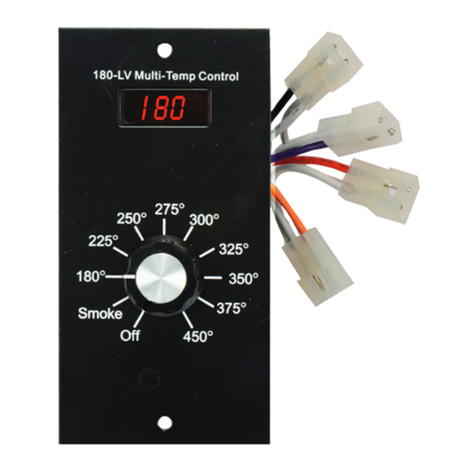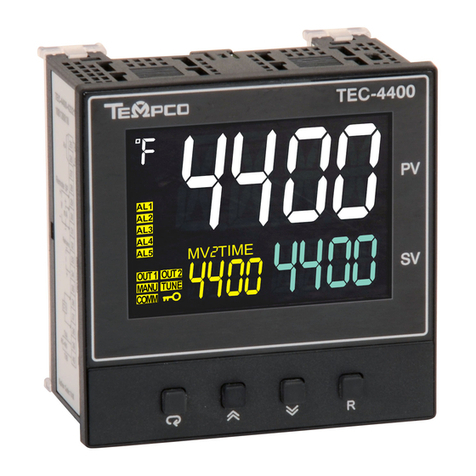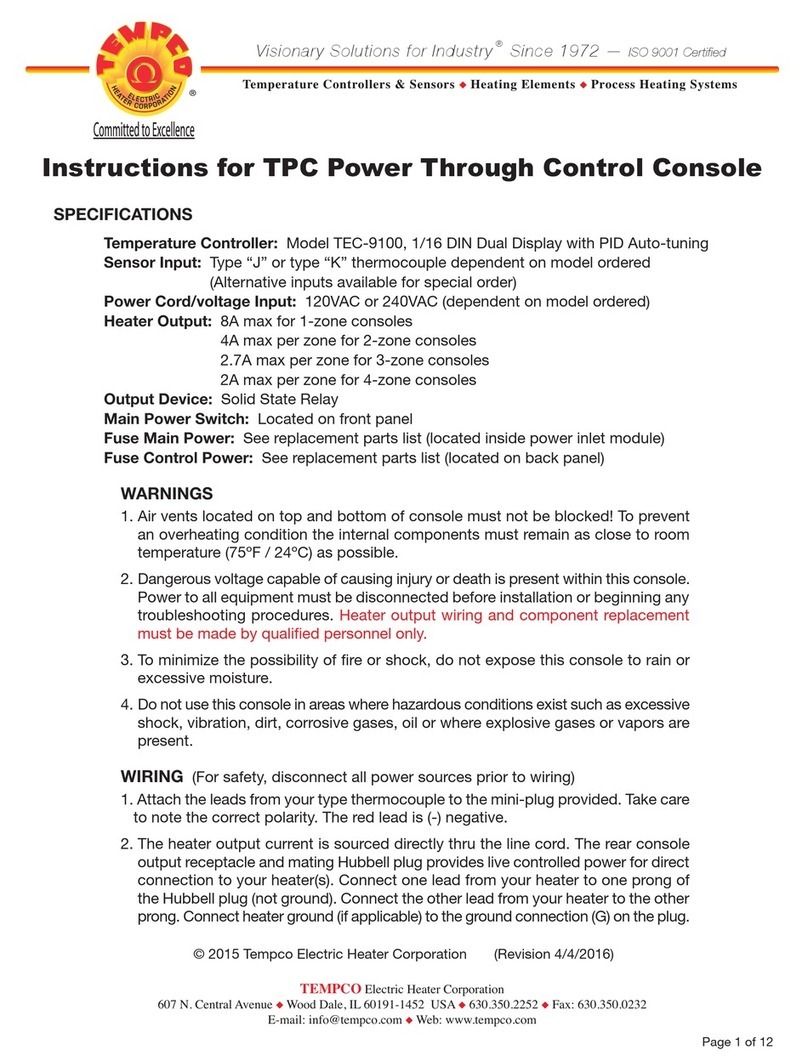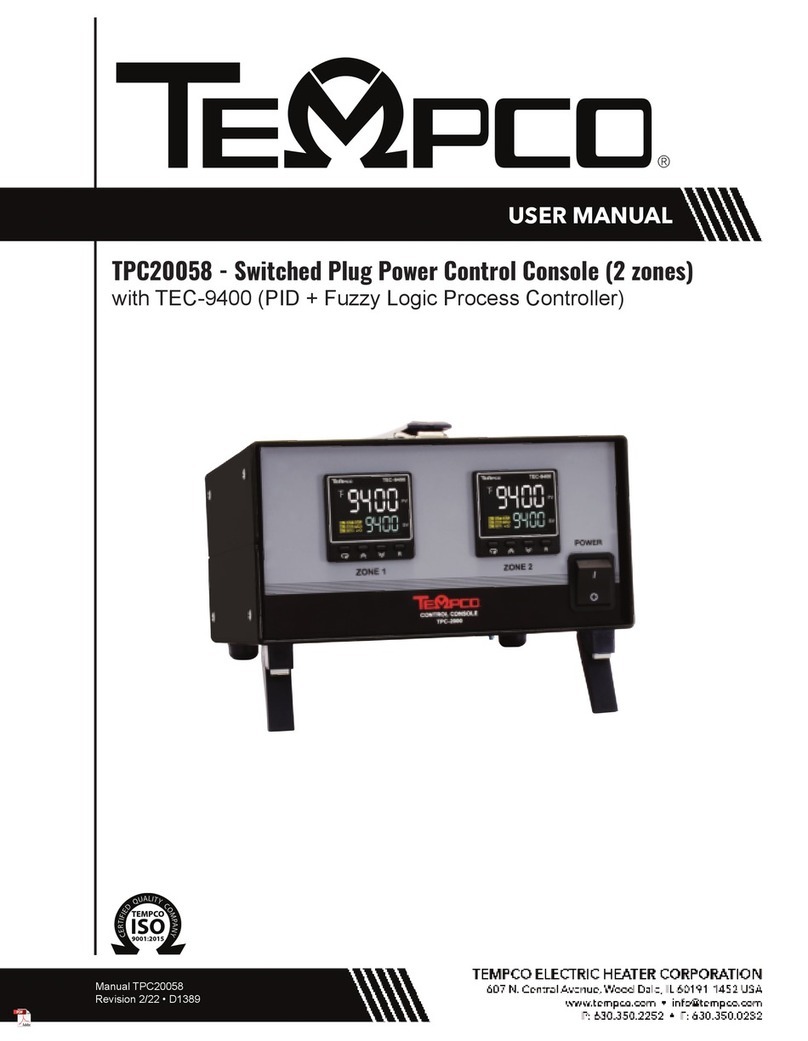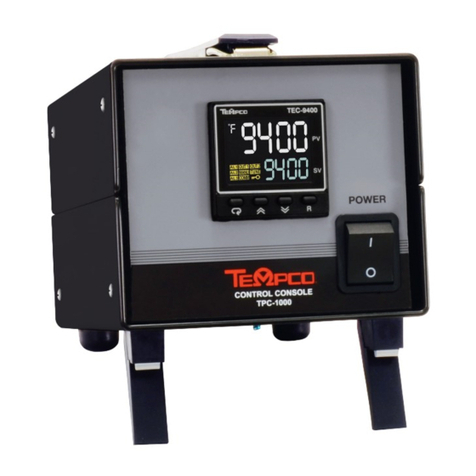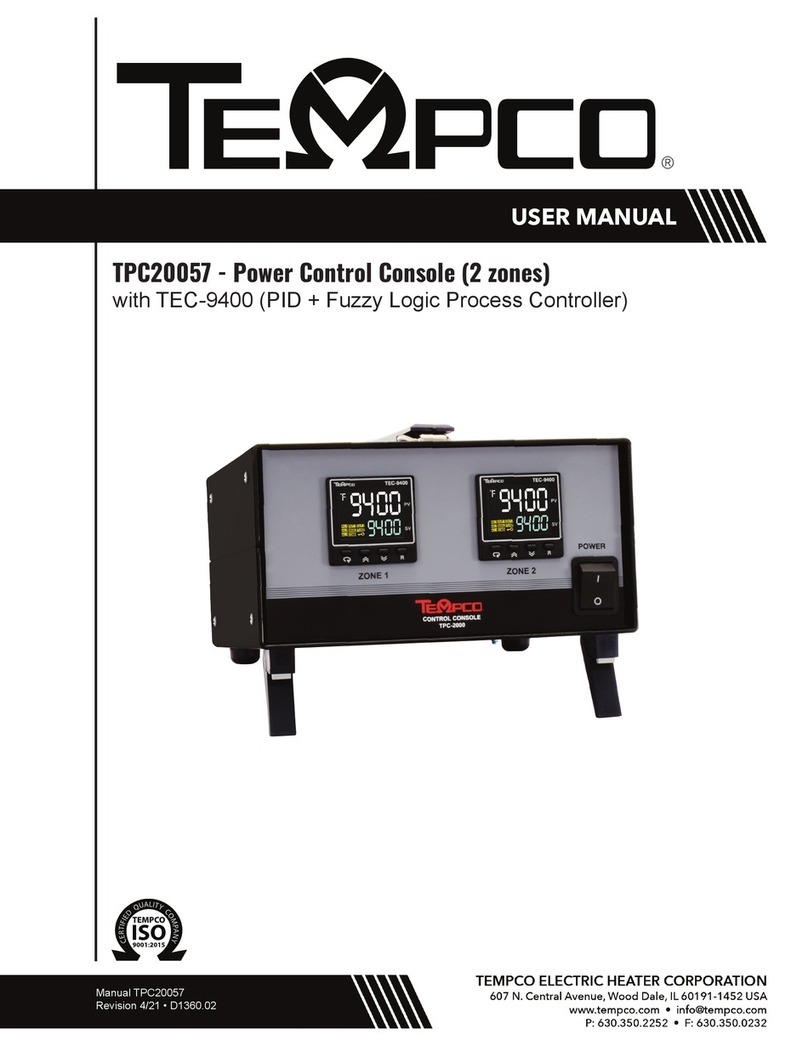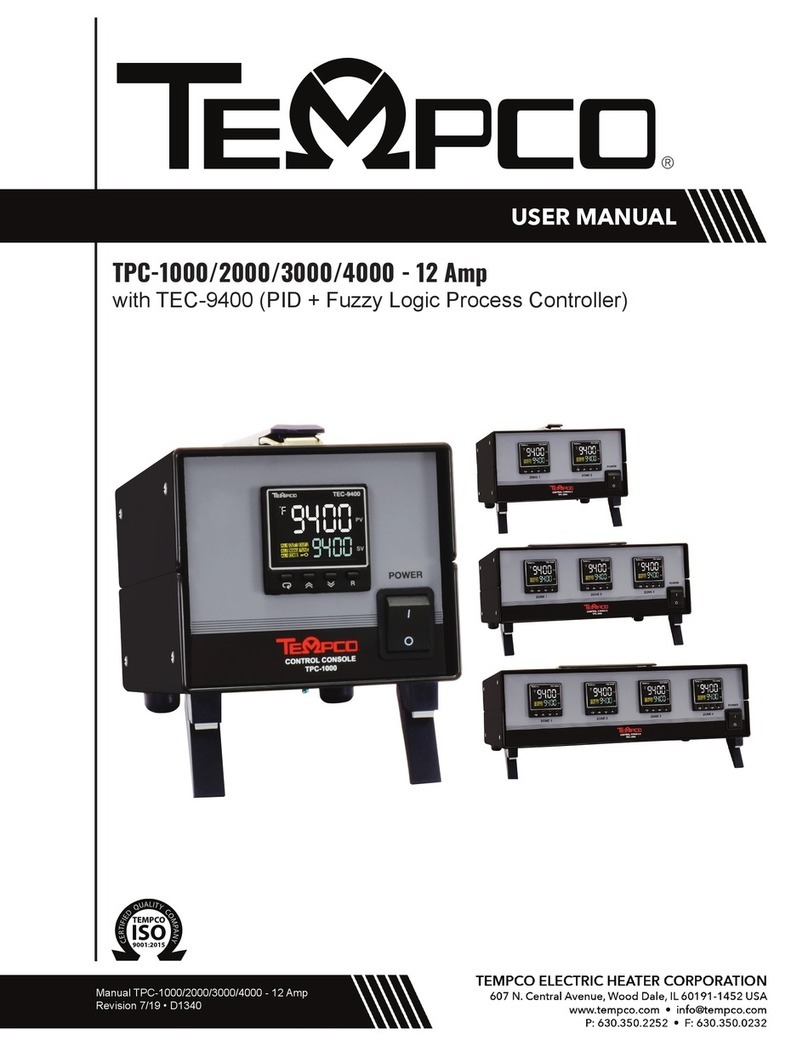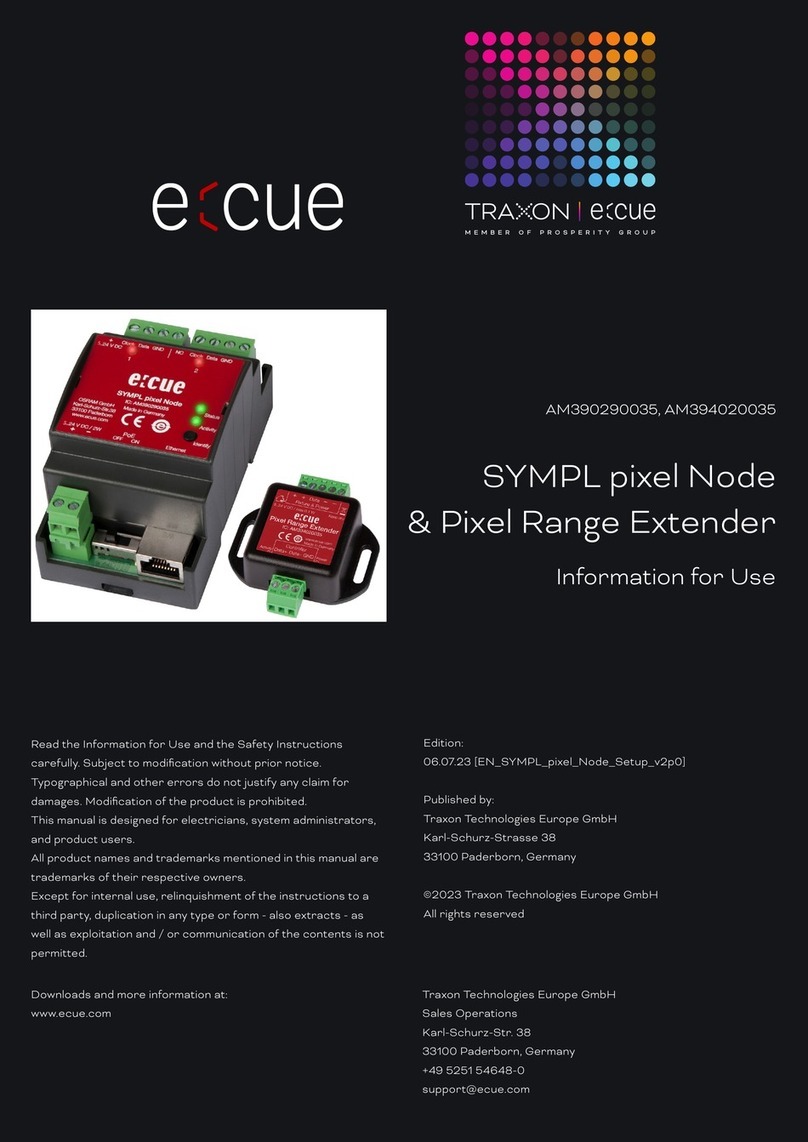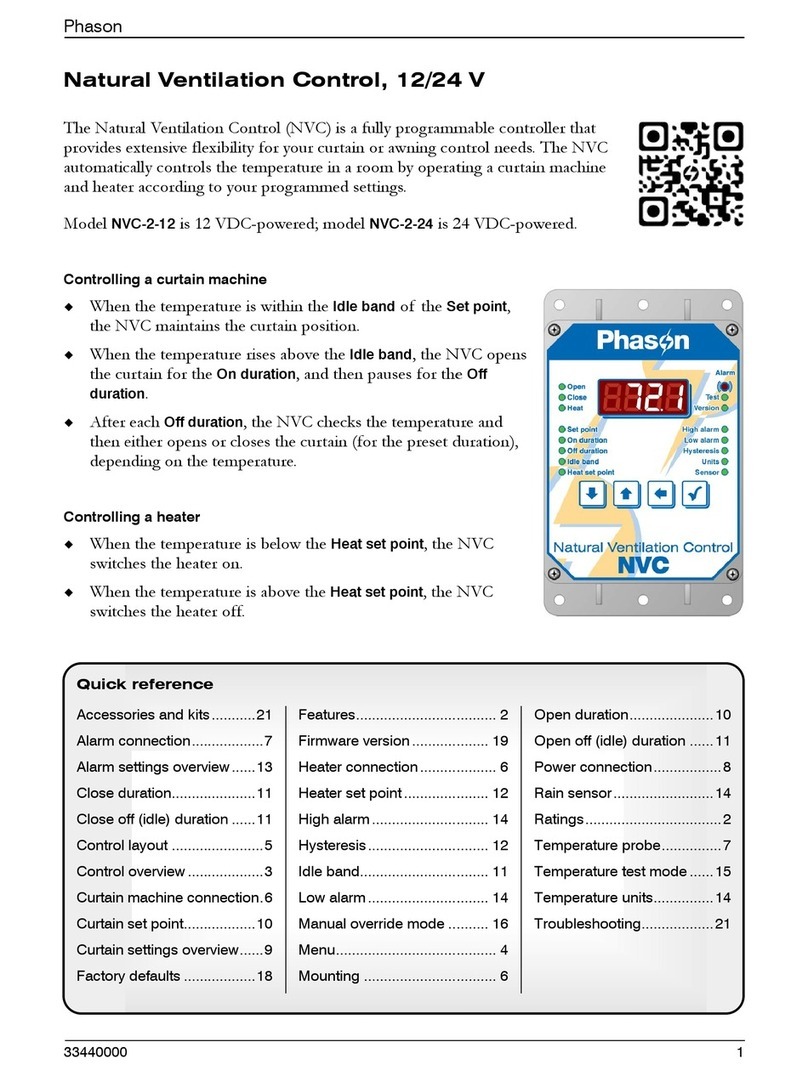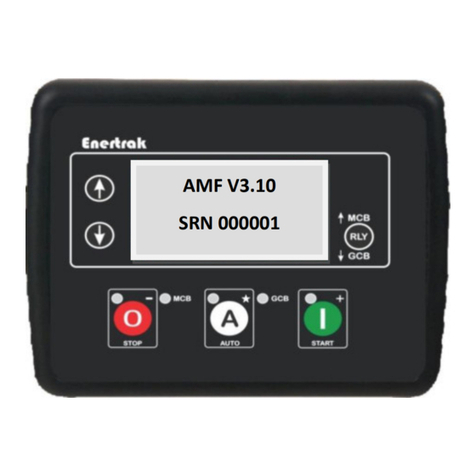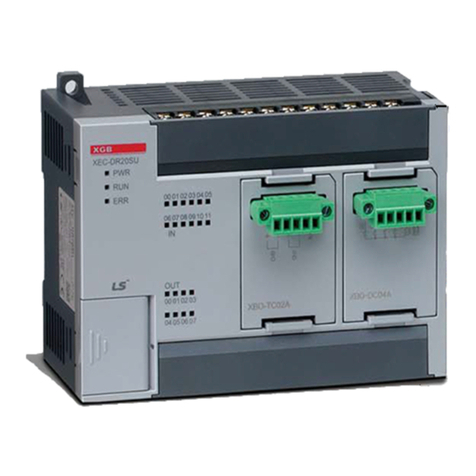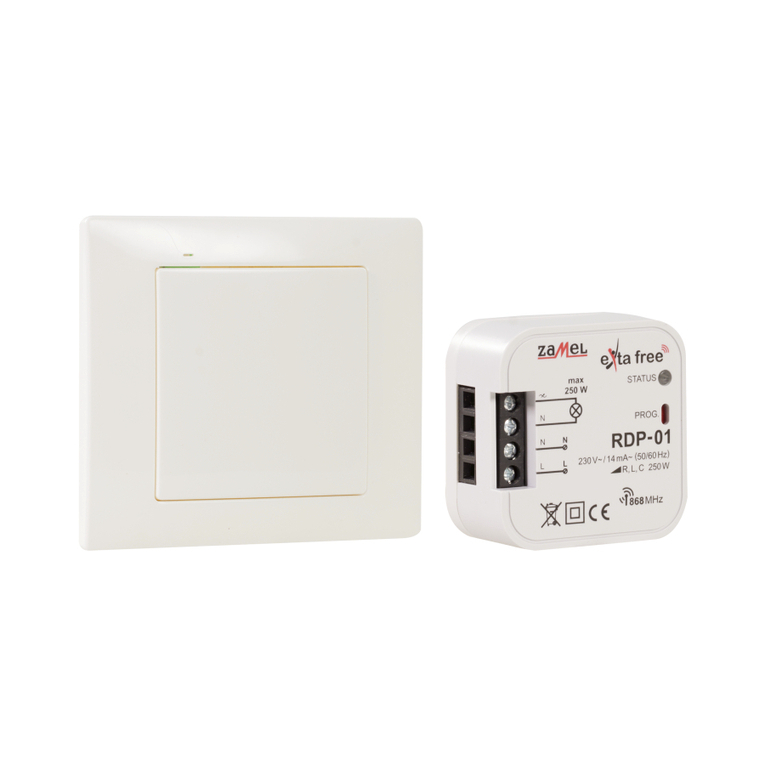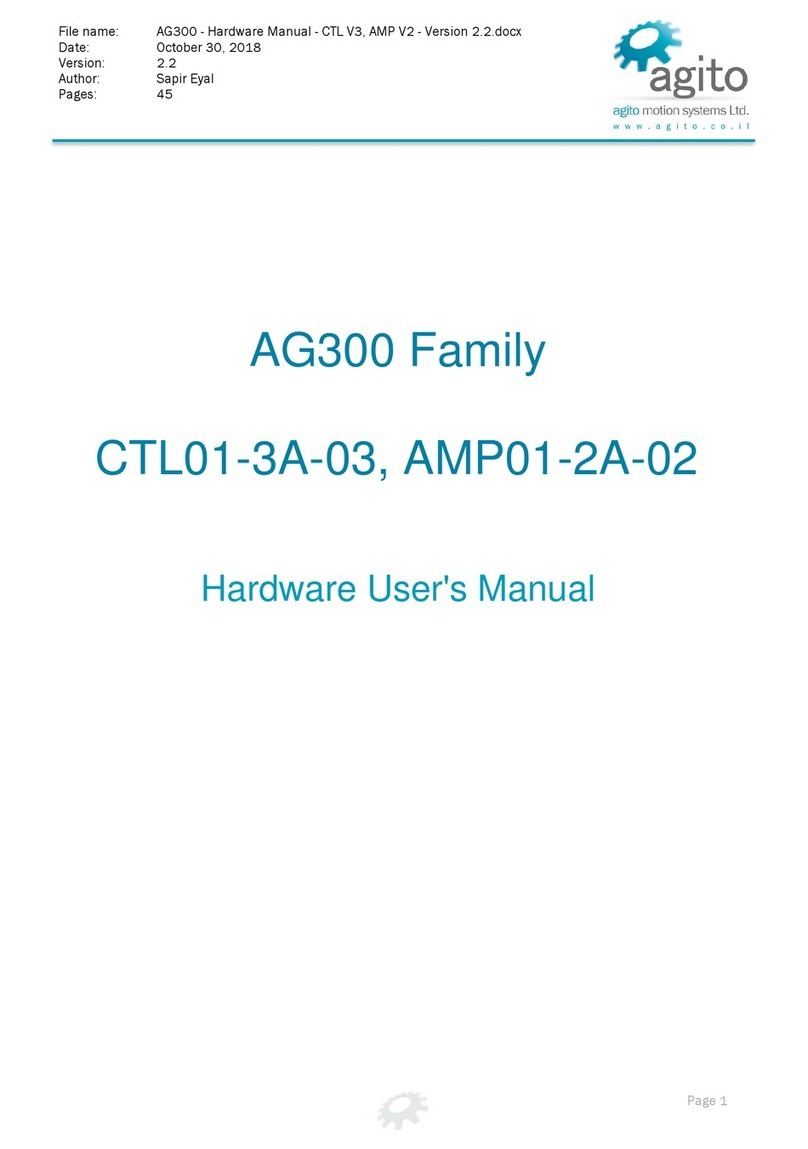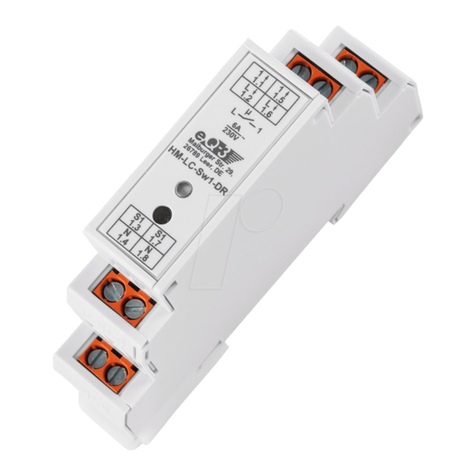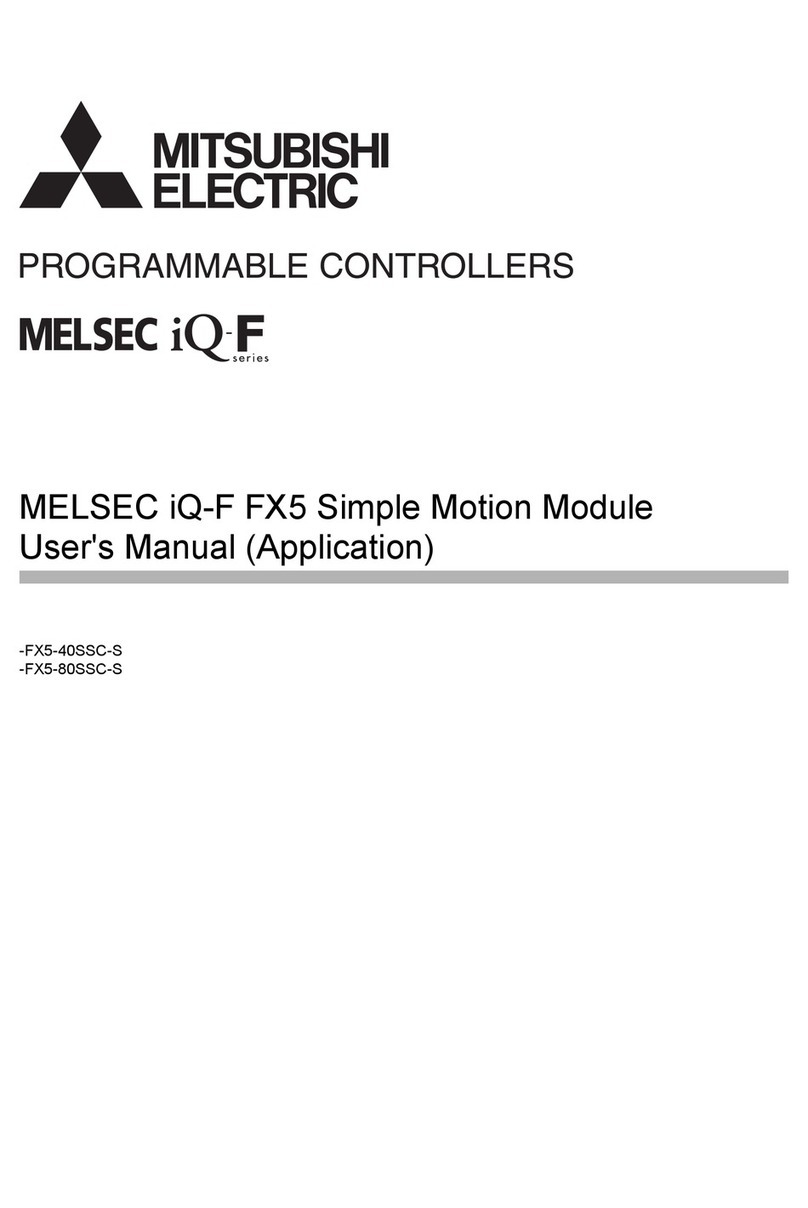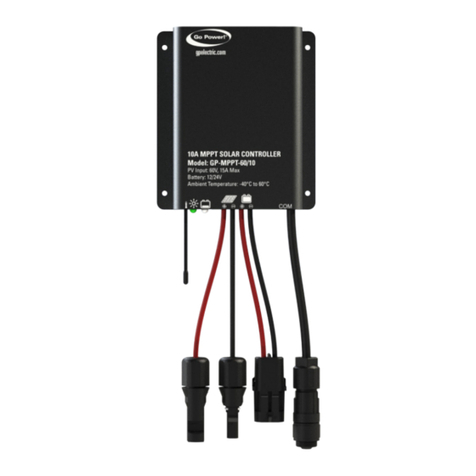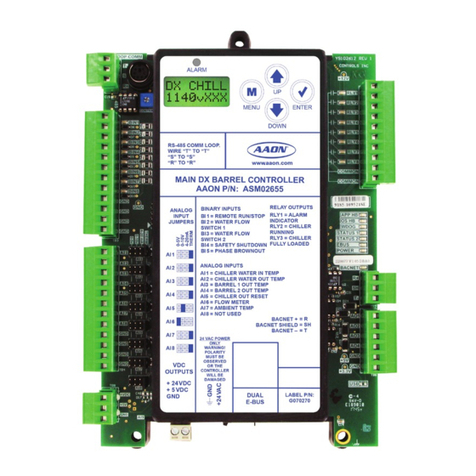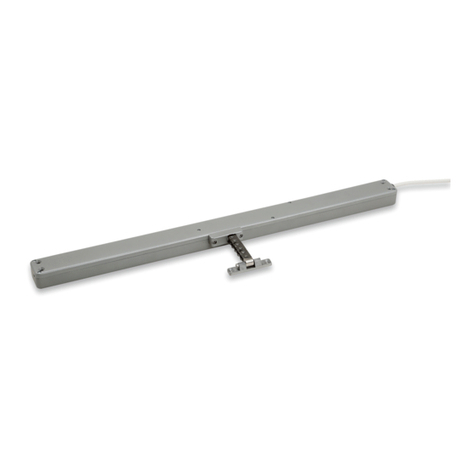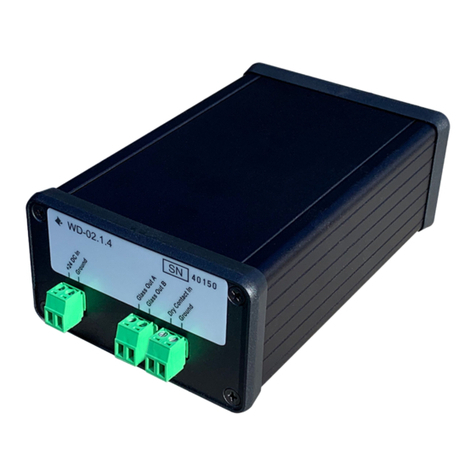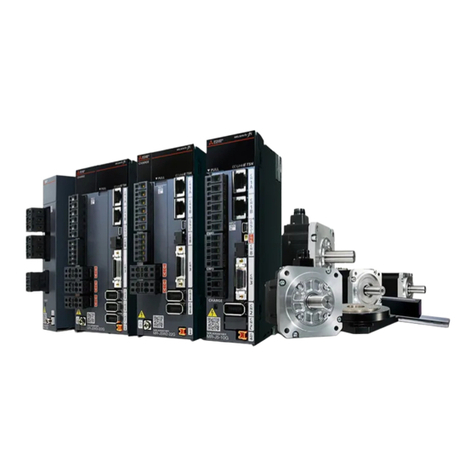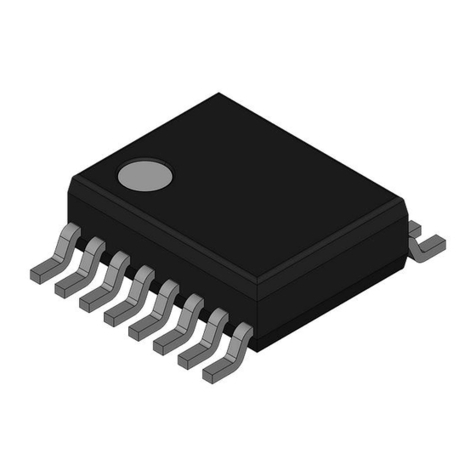Tempco TEC-410 User manual

Instruction Manual
TEC-410
High Limit Control
Microprocessor Based Limit Controller
Manual TEC-410 Revision 8/2008
TEMPCO Electric Heater Corporation
607 N. Central Avenue • Wood Dale, IL 60191-1452 USA
Tel: 630-350-2252 • Toll Free: 800-323-6859
Web: www.tempco.com
Agency Approvals

Warning Symbol
This symbol calls attention to an operating procedure, prac-
tice, or the like which, if not correctly performed or adhered
to, could result in personal injury or damage to or destruc-
tion of part or all of the product and system. Do not proceed
beyond a warning symbol until the indicated conditions are
fully understood and met.
Using the Manual
• Installers . . . . . . . . . . . . . . . . . . . . . Read Chapter 1, 2
• System Designer . . . . . . . . . . . . . . . Read All Chapters
• Expert User . . . . . . . . . . . . . . . . . . . Read Page 11
Information in this user's manual is subject to change with-
out notice.
Copyright © 2008, Tempco Electric Heater Corporation, all
rights reserved. No part of this publication may be repro-
duced, transmitted, transcribed or stored in a retrieval sys-
tem, or translated into any language in any form by any
means without the written permission of Tempco Electric
Heater Corporation.
Contents
Page No.
Chapter 1 Overview
1-1 General . . . . . . . . . . . . . . . . . . . . . . . . . . . . . . . . . 1
1-2 Ordering Code . . . . . . . . . . . . . . . . . . . . . . . . . . . 1
1-3 Programming Port . . . . . . . . . . . . . . . . . . . . . . . . 2
1-4 Keys and Displays . . . . . . . . . . . . . . . . . . . . . . . . 2
1-5 Menu Overview . . . . . . . . . . . . . . . . . . . . . . . . . . 6
1-6 Menu Overview . . . . . . . . . . . . . . . . . . . . . . . . . . 7
1-7 Parameter Descriptions. . . . . . . . . . . . . . . . . . . . . 8
Chapter 2 Installation
2-1 Unpacking . . . . . . . . . . . . . . . . . . . . . . . . . . . . . . 11
2-2 Mounting . . . . . . . . . . . . . . . . . . . . . . . . . . . . . . . 11
2-3 Wiring Precautions . . . . . . . . . . . . . . . . . . . . . . . 11
2-4 Power Wiring . . . . . . . . . . . . . . . . . . . . . . . . . . . 12
2-5 Sensor Installation Guidelines . . . . . . . . . . . . . . 12
2-6 Thermocouple Input Wiring . . . . . . . . . . . . . . . . 12
2-7 RTD Input Wiring . . . . . . . . . . . . . . . . . . . . . . . . 13
2-8 Linear DC Input Wiring . . . . . . . . . . . . . . . . . . . 13
2-9 Event Input Wiring . . . . . . . . . . . . . . . . . . . . . . . 14
2-10 Output 1 Wiring . . . . . . . . . . . . . . . . . . . . . . . . 14
2-11 Output 2 Wiring . . . . . . . . . . . . . . . . . . . . . . . . 15
2-12 RS-485 . . . . . . . . . . . . . . . . . . . . . . . . . . . . . . . 16
2-13 RS-232 . . . . . . . . . . . . . . . . . . . . . . . . . . . . . . . 16
2-14 Retransmission . . . . . . . . . . . . . . . . . . . . . . . . . 16
Chapter 3 Programming
3-1 Process Input . . . . . . . . . . . . . . . . . . . . . . . . . . . 17
3-2 Limit Control . . . . . . . . . . . . . . . . . . . . . . . . . . . 17
3-3 Set Point Range . . . . . . . . . . . . . . . . . . . . . . . . . 18
3-4 PV Shift . . . . . . . . . . . . . . . . . . . . . . . . . . . . . . . . 13
3-5 Digital Filter . . . . . . . . . . . . . . . . . . . . . . . . . . . . 18
3-6 Process Alarms . . . . . . . . . . . . . . . . . . . . . . . . . . 19
3-7 Data communication . . . . . . . . . . . . . . . . . . . . . . 20
3-8 Process Variable (PV) Retransmission . . . . . . . . 20
3-9 Signal Conditioner DC Power Supply . . . . . . . . 21
3-10 Remote Reset . . . . . . . . . . . . . . . . . . . . . . . . . . 21
3-11 Remote Lock . . . . . . . . . . . . . . . . . . . . . . . . . . . 22
3-12 Limit Annunciator . . . . . . . . . . . . . . . . . . . . . . 22
3-13 Reference Data . . . . . . . . . . . . . . . . . . . . . . . . . 22
Chapter 4 Application . . . . . . . . . . . . . . . . . . . . 23
Chapter 5 Calibration . . . . . . . . . . . . . . . . . . . . . . 25
Chapter 6 Specifications . . . . . . . . . . . . . . . . . . . 27
Chapter 7 Modbus Communications
7-1 Functions Supported . . . . . . . . . . . . . . . . . . . . . . 29
7-2 Exception Responses . . . . . . . . . . . . . . . . . . . . . 30
7-3 Parameter Table . . . . . . . . . . . . . . . . . . . . . . . . . 30
7-4 Data Conversion . . . . . . . . . . . . . . . . . . . . . . . . . 32
7-5 Communication Examples. . . . . . . . . . . . . . . . . . 33
Appendix
A-1 Error Codes . . . . . . . . . . . . . . . . . . . . . . . . . . . . 34
A-2 Warranty . . . . . . . . . . . . . . . . . . . . . . . . . . . . . . . 35
Figures & Tables
Page No.
Figure 1.1 Access Overview . . . . . . . . . . . . . . . . . . . . 2
Figure 1.2 Front Panel Deplay . . . . . . . . . . . . . . . . . . 3
Figure 1.3 Power Up Sequence . . . . . . . . . . . . . . . . . 4
Figure 1.4 High Limit Operation . . . . . . . . . . . . . . . . 7
Figure 1.5 Low Limit Operation. . . . . . . . . . . . . . . . . 7
Figure 1.6 High/Low Limit Operation . . . . . . . . . . . . 7
Figure 2.1 Mounting Diagram . . . . . . . . . . . . . . . . . 11
Figure 2.2 Lead Termination . . . . . . . . . . . . . . . . . . . 11
Figure 2.3 Rear Terminal Connection Diagram . . . . 11
Figure 2.4 Power Supply Connections . . . . . . . . . . . 12
Figure 2.5 Thermocouple Input Wiring . . . . . . . . . . 12
Figure 2.6 RTD Input Wiring. . . . . . . . . . . . . . . . . . . 13
Figure 2.7 Linear Voltage Input Wiring . . . . . . . . . . 13
Figure 2.8 Linear Current Input Wiring . . . . . . . . . . 13
Figure 2.9 Event Input Wiring . . . . . . . . . . . . . . . . . . 14
Figure 2.10 Output 1 Wiring . . . . . . . . . . . . . . . . . . . 14
Figure 2.11 Output 2 Wiring . . . . . . . . . . . . . . . . . . . 15
Figure 2.12 RS-485 Wiring . . . . . . . . . . . . . . . . . . . . 16
Figure 2.13 RS-232 Wiring . . . . . . . . . . . . . . . . . . . . 16
Figure 2.14 Configuration of RS-232 Cable . . . . . . 16
Figure 2.15 Retransmission Wiring . . . . . . . . . . . . . 16
Figure 3.1 Conversion Curve for Linear Type
Process Value . . . . . . . . . . . . . . . . . . . . . . 17
Figure 3.2 Filter Characteristics. . . . . . . . . . . . . . . . . 18
Figure 3.3 Normal Process Alarm . . . . . . . . . . . . . . . 19
Figure 3.4 Latching Process Alarm . . . . . . . . . . . . . . 19
Figure 3.5 DC Power Supply Application . . . . . . . . . 20
Figure 3.6 Remote Reset Application . . . . . . . . . . . . 22
Figure 3.7 Remote Lock Application. . . . . . . . . . . . . 22
Figure 4.1 Over Temperature Protection with
Remote Reset . . . . . . . . . . . . . . . . . . . . . . 23
Figure 5.1 Flow Chart for Manual Calibration . . . . . 25
Figure 5.2 Cold Junction Calibration Setup . . . . . . . 25
Figure 5.3 RTD Calibration . . . . . . . . . . . . . . . . . . . . 26
Table 1.1 DIP Switch Configuration . . . . . . . . . . . . . 2
Table 1.2 Display Form of Characters . . . . . . . . . . . . 3
Table 6.1 Input Characteristics . . . . . . . . . . . . . . . . . 27
Table A.1 Error Codes and Corrective Actions . . . . . 34

1
Chapter 1 Overview
1–1 General
Power Input
4 = 90-250 Vac
5 = 11-26 Vac / Vdc
9 = Other
Signal Input
1 = Standard Input
Thermocouple: J, K, T, E,
B, R, S,N ,L, C, P
RTD: PT100 DIN,
PT100 JIS
mV0-60 mV
2 = Voltage: 0-1V
3 = Voltage: 0-10V
4 = 0-20 mA
5 = 0-5V
9 = Other
Output 1
1 = Relay: 2A / 240 Vac
2 = Pulsed voltage to drive
SSR drive:
5V/30mA
6 = Triac output
1A / 240 Vac,SSR
C = Pulsed voltage to drive
SSR drive:
14V/40mA )
9 = Other
Output 2
0 = None
1 = Form C Relay: 2A/240 Vac
2 = Pulsed voltage to drive SSR drive:
5V, /30mA
6 = Triac Output1A/240 Vac SSR
7 = RS-485 Data Interface,
TEC 920 only
8 = Isolated 20V @ 25 mA DC,
Output Power Supply
A = Isolated 12V @ 40 mA DC,
Output Power Supply
B = Isolated 5V @ 80 mA DC,
Output Power Supply
H = Other
Communication
0 = None
1 = RS-485 Interface
2 = RS-232 Interface
3 = Retransmit 4-20 mA/0-20 mA
4 = Retransmit 1-5 V/0-5 V
5 = Retransmit 0-10 V
9 = Other
TEC-410 –
Standard Mounting
1 = IP50 standard
2 = °C on faceplate
123456
1–2 Ordering Code
Accessories
TEC99001 = Smart Network Adapter for third party software,
converts 255 channels
of RS-485 or RS-422 to RS-232 Network
TEC99001 = Smart Network Adapter for programming port to
RS-232 interface
TEC99030 = Configuration Software
The TEC-410 limit control is an over temperature protec-
tion or a high limit safety device with a latching output that
removes power in an abnormal condition when the process
temperature is higher than the high limit set point or lower
than the low limit set point.
The unit is powered by 11–26 or 90–250VDC/VAC supply,
voltage incorporates a 3 amp form C relay for limit control,
a universal input which is fully programmable for PT100,
thermocouple types J, K, T, E, B, R, S, N, L, and 0-60mV,
and an option port is available for one of the following
functions: RS-232, RS-485 communication interface and
Retransmission. Alternative output options include SSR
drive and triac. The input signal is digitized by using an 18-
bit Analog to Digital converter. Its fast sampling rate (5
times/second) allows the TEC-410 to control fast processes
such as pressure and flow in addition to temperature.
RS-485 digital communication is available as an additional
option. This option allows the TEC-410 to be integrated
with a supervisory control system. An alarm output is
another option. A variety of alarm functions and alarm
modes can be programmed for a specific application. The
DC power supply output option is used for an external sen-
sor or transmitter. The standard event input option can be
programmed for remote reset or remote lock out signal
input. The limit annunciator option can be used to control
an alarm buzzer.
Three different methods can be used to program the
TEC-410.
1. Use the keys on the front panel to program the unit
manually
2. Use a PC and setup software to program the unit via the
RS-485 port.
3. Use a PC and configuration software to program the
unit via the programming port.
High accuracy, maximum flexibility, fast response, and user
friendly operation are the main features of the TEC-410
high limit controller.

2
1–3 Programming Port and DIP Switch
The programming port is used for off-
line automatic setup and testing proce-
dures only. Don't attempt to make any
connection to these pins when the unit
is actively being used in a control appli-
cation.
Front
Panel
Rear
Terminal
TC, RTD, mV
0-1V, 0-10V
0-20 ma
Input
Select
1234
DIP Switch
:ON :OFF
Access Hole
The programming port isused to connect to SNA12A
for automatic programming, also can be connected to
ATE system for automatic testing & calibration.
1 2 3 4
ON DIP
Figure 1.1
Access Overview
RESET KEY:
This key is used to:
1. Revert the limit condition after the process is
within the limit.
2. Revert the display to the normal display.
3. Reset the latching alarm, once the alarm con-
dition is removed.
4. Reset the limit annunciator.
Note:
If the RESET key is left pressed, only ONE reset
operation will
occur. If the unit subsequently goes into a state
where reset is
required again, the RESET key (or remote reset
contacts) must be
released (opened) and pressed (closed) again.
UNLOCK KEY 4 seconds Press the RESET
key for 4 seconds to enable up/down key
function,and the lock indicator will be extinguished.
However, this function is disabled when the EI
input pins are closed and remote lock is selected for
EIFN (Event Input Function). See section 3-11
R
R
1–4 Keys and Displays
KEYPAD OPERATION
SCROLL KEY:
1. Select a set point to be displayed.
2. Select a parameter to be viewed or adjusted.
3. Advance display from a parameter code to the
next parameter code.
ENTER KEY : 4 seconds, 6 seconds.
Press the enter key for 4 seconds to enter the
setup menu.
Press the enter key for 6 seconds to enter the
calibration mode.
UP KEY:
This key is used to increase the selected
parameter value when the lock indicator is
off.
DOWN KEY:
This key is used to decrease the selected
parameter value when the lock indicator is
off.
Table 1.1
DIP Switch Configuration

3
: IndicatesAbstract Characters
AEINSX
BFJOTY
CGKPUZ
cHLQV
?
Dh
MRW=
Table 1.2
Display Form of Characters
Lock
R
TEC-410
Limit Control
Output 1 ~ 2 Indicator
Process Unit Indicator
4 Buttonsfor ease of control
setup and set point adjustment.
Upper Display, to display process value,
menu symbol and error code etc.
Lower Display, to display set point
value, parameter value etc.
Lock
Status
Indicator
The reference data are reset aslong asthe reset key
ispressed for 4 seconds. See section 3-13.
TEMPCO
Out1
Out2
Figure 1.2
Front Panel Display
How to display a 5-digit number:
For a number with a decimal point, the display will be shifted one digit to the right:
-199.99 will be displayed as -199.9, 4553.6 will be displayed as 4553
For a number without a decimal point, the display will be divided into two alternating phases:
-19999 will be displayed as
45536 will be displayed as
-9999 will be displayed as

4
NORMAL DISPLAY
During normal operation, the unit will display the process value and the word SAFE.
ABNORMAL DISPLAY
Whenever the process is outside the normal range, the lower display will display the limit
set point value, instead of displaying the word SAFE.
SENSOR BREAK DISPLAY
If a breakis detected in the sensor circuit, the display will show:
SENB
A-D FAILURE DISPLAY
If failure is detected in the A-D converter circuit, the display will show:
AD.ER
Lock
R
LIMIT CONTROL
LIMIT CONTROL
TEC-410
TEMPCO
Lock
R
LIMIT CONTROL
LIMIT CONTROL
TEC-410
TEMPCO
All segments of display and indicators are left
off for 0.5 second.
All segments of display and indicators are lit
for 1.5 second.
Figure 1.3
Power Up Sequence
POWER UP SEQUENCE

5
Display program code of the product for 1.5 seconds.
The example shows program no.5 with version 10.
Display Date Code for 1.5 seconds.The example shows Year
2006 (6), Month February (2), Date 25th. This means that the
product is produced on February 25th, 2006. Note that the month
code A is for October, B is for November and C is for December.
Display the serial number (001-999)for 1.5 seconds.
Display the hours used for 1.5 seconds. The example shows that the
unit has been used for 23456.7 hours since production.
Lock
R
LIMIT CONTROL
LIMIT CONTROL
TEC-410
TEMPCO
Lock
R
LIMIT CONTROL
LIMIT CONTROL
TEC-410
TEMPCO
Lock
R
LIMIT CONTROL
LIMIT CONTROL
TEC-410
TEMPCO
Verify that all electrical connections have been made properly before apply-
ing power to the unit.
During power up, a self-test procedure will be performed within 6.5 seconds.
During the self-test period all outputs are left off. When the self-test proce-
dure is complete, the unit will revert to normal operation.

6
INPT
UNIT
RESO
IN.LO
IN.HI
SHIF
FILT
OUT1
O1.HY
HSP. L
HSP. H
LSP. L
LSP. H
OUT2
ADDR
BAUD
PARI
AL.FN
AL.MD
AL.HY
AL.FT
EIFN
DISP
Input type
Process unit
Display resolution
Low scale value for linear
input
High scale value for linear
input
PV shift (offset) value
PV filter time constant
Output 1 function
Output 1 hysteresisvalue
Lower limit of HSP1
Lower limit of LSP1
Upper limit of HSP1
Upper limit of LSP1
Output 2 function
Address for digital
communication
Baud rate
Parity bit
Alarm function
Alarm mode
Alarm hysteresisvalue
Alarm failure transfer
Event input function
Normal display format
Press
for 4 sec.
PV.HI
PV.LO
Max. historical PV
Min. historical PV
T.ABN Abnormal time
PV Value
SP1 or SAFE
HSP1 Value
__ __ __ __
LSP1 Value
__ __ __ __
SP2 Value
__ __ __ __
High limit
setpoint 1
value
Low limit
setpoint 1
value
Set point 2
value
Setup Mode
Press
for 2 sec. Calibration Mode
1–5 Menu Overview
Note 1. The flow charts show a complete listing of parameters. For the actual application,
the number of available parameters are dependent on the setup conditions, and
should be less than that shown in the flow charts.
Note 2. Press key for 4 seconds to enable up/down key function and extinguish the
LOCK indicator.
R

7
HSP1
ON
OFF
OUT1 Relay
A, B ,C = Reset isapplied
O1.HY = Output1 hysteresis
PV
AB C
HSP1 – O1.HY
Figure 1.4
High Limit Operation
HIGH LIMIT OPERATION
If Hi. is selected for OUT1, the unit will perform
high limit control. When power is applied the OUT1
relay is de-energized. After the 6.5 second self-test
period, if the process is below the high limit set point
(HSP1) the output 1 relay will be energized and the
OP1 indicator will go off.If the process goes above
the high limit set point, the relay will be de-ener-
gized, the OP1 indicator will go on, and the display
will show the process value. After the process falls
below the high limit set point and the RESET key is
pressed or the remote reset input is applied, the relay
will be energized and the OP1 indicator will go off.
1–6 Limit Control Operation
LOW LIMIT OPERATION
If Lo. is selected for OUT1, the unit will perform low
limit control. When power is applied the OUT1 relay is
de-energized. After the 6.5 second self-test period, if the
process is above the low limit set point (LSP1) the out-
put 1 relay will be energized and the OP1 indicator will
go off.If the process goes below the low limit set point,
the relay will be de-energized, the OP1 indicator will go
on, and the display will show the process value. After
the process rises above the low limit set point and the
RESET key is pressed or the remote reset input is
applied, the relay will be energized and the OP1 indica-
tor will go off.
LSP1
ON
OFF
OUT1 Relay
A, B ,C = Reset isapplied
O1.HY = Output1 hysteresis
AB C
LSP1 + O1.HY
Figure 1.5
Low Limit Operation
HIGH/LOW LIMIT OPERATION
If Hi.Lo is selected for OUT1, the unit will per-
form high/low limit control. When power is
applied, the OUT1 relay is de-energized. After the
6.5 second self-test period, if the process is below
the high limit set point (HSP1) and above the low
limit set point (LSP1), the output 1 relay will be
energized and the OP1 indicator will go off.
If the process goes above the high limit set point
or below the low limit set point, the relay will be
de-energized, the OP1 indicator will go on, and
the display will show the process value. After the
process is within the normal operation range, and
the RESET key is pressed or the remote reset
input is applied, the relay will be energized and
the OP1 indicator will go off.
LSP1 + O1.HY
HSP1
LSP1
HSP1 – O1.HY
ON
OFF
OUT1 Relay
A, B, C, D, E, F =Reset isapplied
O1.HY= Output1 hysteresis
ABC D EF
Figure 1.6
High/Low Limit Operation

8
Parameter
Notation
Default
Value
Parameter Description
(Refer to Page:) Range
Input sensor
selection
(Page 11 & 23)
1
(0)
Low Limit Set point 1 Low: LSP.L High: LSP. H
0.0°C
(32.0°F)
High Limit Set point 1 Low: HSP.L High: HSP. H
100.0°C
(212.0°F)
Process unit 0
(1)
Display Resolution 1
Low scale value for
Iinear Input (Page 11)
High scale value for
Iinear Input (Page 11)
Low: -19999 High: IN.HI
Low: IN.LO High: 45536
0
-200.0°C
(-360.0°F)
0.0
Low: 200.0°C
(360.0°F)
High:
100.0
PV Filter Time
Constant
(Page 15) 2
PV Shift (offset)
Value
0) 0: 0 second time constant
1) 0.2 : 0.2 second time constant
2) 0.5 : 0.5 second time constant
3) 1: 1 second time constant
4) 2: 2 secondstime constant
5) 5: 5 secondstime constant
6) 10 : 10 secondstime constant
7) 20 : 20 secondstime constant
8) 30 : 30 secondstime constant
9) 60 : 60 secondstime constant
0) NO.DP : No decimal point
1) 1-DP : 1 decimal digit
2) 2-DP : 2 decimal digits
3) 3-DP : 3 decimal digits
0) J-TC : J type thermocouple
1) K-TC: K type thermocouple
2) T-TC : T type thermocouple
3) E-TC : E type thermocouple
4) B-TC: B type thermocouple
5) R-TC : R type thermocouple
6) S-TC : Stype thermocouple
7) N-TC : N type thermocouple
8) L-TC : L type thermocouple
9) C-TC : C type thermocouple
10) P-TC : P type thermocouple
11) PTDN : PT 100 ohmsDIN curve
12) PTJS: PT 100 ohmsJIScurve
13) 4-20 : 4-20 mA linear current
input
14) 0-20 : 0-20 mA linear current
input
15) 0-60 : 0-60 mV linear millivolt
input
16) 0-1V: 0-1V linear voltage input
17) 0-5V: 0-5V linear voltage input
18) 1-5V: 1-5V linear voltage input
19) 0-10: 0-10V linear voltage input
0) QC: Degree C unit
1) QF: Degree F unit
2) PU: Process unit
HSP1
HSP1
LSP1
LSP1
Set point 2 Value for
Output 2 Low: -19999 High: 45536
90.0°C
(194.0°F)
SP2
SP2
RESO
RESO
INLO
INLO
INPE
INPT
INHI
INHI
SHIF
SPIF
Output 1 Function
UNIT
UNIT
FILT
FILT
OUT1
OUT1
2) HI. : High limit control
3) LO. : Low limit control
4) HI.LO : High/Low limit control
2
1–7 Parameter Descriptions

9
Communication
function
(Page 23)
0) NONE: No communication
1) RTU : ModbusRTU
mode protocol
2) 4-20: 4-20 mA DC
transmission output
3) 0-20: 0 - 20 mA DC
transmission output
4) 0-5V: 0 - 1V DC
transmission output
5) 1-5V: 0 - 5V DC
transmission output
6) 0-10: 1 - 5V DC
transmission output
1
COMM
COMM
Baud rate of digital
communication
(Page 25)
0) 0.3: 0.3 Kbits/sbaud rate
1) 0.6: 0.6 Kbits/sbaud rate
2) 1.2: 1.2 Kbits/sbaud rate
3) 2.4: 2.4 Kbits/sbaud rate
4) 4.8: 4.8 Kbits/sbaud rate
5) 9.6: 9.6 Kbits/sbaud rate
6) 14.4: 14.4 Kbits/sbaud rate
7) 19.2: 19.2 Kbits/sbaud rate
8) 28.8: 28.8 Kbits/sbaud rate
9) 38.4: 38.4 Kbits/sbaud rate
Parity bit of digital
communication
0) EVEN: 8 bit even parity
1) ODD: 8 bit odd parity
2) NONE: 8 bit none parity
Analog/Retransmission
Output Function
0) PV: Process Value
1) HSP1: High Limit Set point 1
2) LSP1: Low Limit Set point 1
BAUD
BAUD
PARI
PARI
AOFN
AOFN
Low: -19999 High: 45536
0.0°C
(32.0°F)
Analog Output Low
Scale Value
AOLO
AOLO
Low: -19999 High: 45536
100.0°C
(212.0°F)
Analog Output High
Scale Value
AOHI
AOHI
Output 1 Hysteresis
Value Low: 0.1 High: 10.0°C (18.0°F)
.1
O1.HY
O1.HY
Lower Limit of HSP1 Low: -19999 High: HSP. H
0.0°C
(32.0°F)
HSP.L
HSP. L
Upper Limit of HSP1 Low: HSP.L High: 45536
1000.0°C
(1832.0°F)
HSP.H
HSP. H
Lower Limit of LSP1 Low: -19999 High: LSP. H
-100.0°C
(-148.0°F)
LSP.L
LSP. L
Upper Limit of LSP1 Low: :LSP.L High: 45536
0.0°C
(32.0°F)
LSP.H
LSP. H
OUT2
OUT2 Output 2 Function
0) NONE : No Function
1) DCPS : DC power supply output
2) ALN : Alarm Output
3) L-AN : Limit Annunciator
2
Parameter
Notation
Default
Value
Parameter Description
(Refer to Page:) Range

10
Historical Max. value of PV
(Page 23) —
PV.HI
PV.HI
Historical Min. value of PV
(Page 25)
Accumulated Time during
abnormal condition
PV.LO
PV.LO
T.ABN
T.ABN
Alarm Function 6) P.VH.A : Process value high alarm
7) P.VL.A : Process value low alarm
6
AL.FN
AL.FN
Alarm mode
6) NORM : Normal alarm action
7) LTch : Latching alarm action
0
AL.MD
AL.MD
Alarm hystersisvalue Low: 0.1 High: 10°C (18°F)
0.1
AL.HY
AL.HY
Alarm failure transfer
0) OFF : Alarm Output goesoff as
unit fails
1) ON : Alarm Output goeson as
unit fails
1
AL.FT
AL.FT
Event input function
0
EIFN
EIFN
DISP
DISPNormal display format
0) SAFE : Display SAFE
1) HSP1 : Display the value of HSP1
2) LSP1 : Display the value of LSP1
0
Parameter
Notation
Default
Value
Parameter Description
(Refer to Page:) Range
0) NONE : No event function
1) REST : Remote reset for output 1,
output 1 on
2) LOCK : Remote lock for the unit
Low: -19999 High: 45536
Low: -19999 High: 45536
Low: 0 High: 6553.5 minutes—
—

11
Dangerous voltages capable of causing death are
sometimes present in this instrument. Before instal-
lation or beginning any troubleshooting procedures, the
power to all equipment must be switched off and isolated.
Units suspected of being faulty must be disconnected and
removed to a properly equipped workshop for testing and
repair. Component replacement and internal adjustments
must be made by a qualified maintenance person only.
To minimize the possibility of fire or shock hazards
do not expose this instrument to rain or excessive
moisture.
Do not use this instrument in areas under hazardous
conditions such as excessive shock, vibration, dirt,
moisture, corrosive gases or oil. The ambient temperature
of the area should not exceed the maximum rating specified
in chapter 6.
2–1 Unpacking
Upon receipt of the shipment, remove the unit from the car-
ton and inspect the unit for any shipping damage.
If there is any damage due to transit, report it and file a
claim with the carrier. Write down the model number, seri-
al number and date code. for future reference when corre-
sponding with our Service Department. The serial number
(SN) and date code (D/C) are labeled on the box and the
housing of the unit.
2–2 Mounting
Make the panel cutout according to the dimensions shown
in figure 2.1.
Remove the mounting clamps and screws and insert the
controller into the panel cutout. Reinstall the mounting
clamp and screws. Gently tighten the screws until the front
panel fits snugly in the cutout.
Chapter 2 Installation
53 mm
(2-1/8")
Panel
Panel Cutout
92 mm
(3-5/8")
92 mm
(3-5/8")
Figure 2.1 Mounting Diagram
2–3 Wiring Precautions
•Before wiring, verify the correct model number and
options on the label. Switch off the power while checking.
•Care must be taken to ensure that the maximum voltage rating
specified on the label is not exceeded.
•It is recommended that the power for these units be protected
by fuses or circuit breakers rated at the minimum value pos-
sible.
•All units should be installed inside a suitably grounded metal
enclosure to prevent live parts from being accessible to
human hands and metal tools.
•All wiring must conform to appropriate standards of good
practice and local codes and regulations. Wiring must be
suitable for the voltage, current, and temperature rating of
the system.
•Beware not to over-tighten the terminal screws. The torque
should not exceed 1N-m (8.9 lb-in or 10 KgF-cm)
•Unused control terminals should not be used as jumper
points as they may be internally connected, causing damage
to the unit.
•Verify that the ratings of the output devices and the inputs as
specified in chapter 6 are not exceeded.
•Except the thermocouple wiring, all wiring should use
stranded copper conductor with maximum gauge of 18
AWG.
Figure 2.2
Lead Termination
Figure 2.3
Rear Termination Connection Diagram
Notes: 50°C max. air ambient
Use copper conductors (except on T/C input)
ASTM thermocouples (USA), the red colored lead
is always negative.

12
2–4 Power Wiring
The controller is designed to operate at
11–26VAC/VDC to 90–250VAC. Check that the
installation voltage corresponds to the power rating
indicated on the product label before connecting
power to the controller. Near the controller a fuse
and a switch rated at 2A/250VAC should be
equipped as shown in Figure 2-4.
This equipment is designed for installation in an
enclosure which provides adequate protection against
electric shock. The enclosure must be connected to
earth ground.
Local requirements regarding electrical installation should
be rigidly observed. Consideration should be given to pre-
vent unauthorized personnel from accessing the power ter-
minals.
2–5 Sensor Installation Guidelines
Proper sensor installation can eliminate many problems in a
control system. The probe should be placed so that it can
detect any temperature change with minimal thermal lag. In
a process that requires fairly constant heat output, the probe
should be placed close to the heater. In a process where the
heat demand is variable, the probe should be close to the
work area. Some experimentation with probe location is
often required to find the optimum position.
In a liquid process, the addition of agitation will help to
eliminate thermal lag. Since the thermocouple is basically a
point measuring device, placing more than one thermocou-
ple in parallel will provide an average temperature readout
and produce better results in most air heated processes.
Proper sensor type is also a very important factor in obtain-
ing precise measurements. The sensor must have the correct
temperature range to meet the process requirements. In spe-
cial processes, the sensor might have requirements such as
leak-proof, anti-vibration, antiseptic, etc.
Standard sensor limits of error are ±4°F (±2°C) or 0.75% of
the sensed temperature (half that for special limits of error)
plus drift caused by improper protection or an over-temper-
ature occurrence. This error is far greater than controller
error and cannot be corrected on the sensor except by prop-
er selection and replacement.
90 250 VAC or
11 26 VAC / VDC
~
~
Fuse
1
2
3
4
5
6
7
8
9
10
11
12
13
14
15
16
17
18
19
20
Figure 2.4
Power Supply Connections
2–6 Thermocouple Input Wiring
Thermocouple input connections are shown in figure 2-5.
The correct type of thermocouple extension lead-wire or
compensating cable must be used for the entire distance
between the unit and the thermocouple, ensuring that the
correct polarity is observed throughout. Junction/terminal
blocks or splices in the cable run should be avoided, if pos-
sible.
If the length of the thermocouple plus the extension wire is
too long, it may affect the temperature measurement. A 400
ohms K type or a 500 ohms J type thermocouple lead resist-
ance will produce approximately 1°C temperature error.
1
2
3
4
5
6
7
8
9
10
11
12
13
14
15
16
17
18
19
20
1
1
2
2
3
3
4
4
ON
ON
+
Dip Switch
—
Figure 2.5
Thermocouple Input Wiring

13
2-7 RTD Input Wiring
The RTD connections are shown in figure 2-6,
with the compensating lead connected to terminal
19. For two-wire RTD inputs, terminals 19 and 20
should be jumpered. A three-wire RTD offers the
capability of lead resistance compensation, pro-
vided that the three leads are of same gauge and
equal length.
Two-wire RTD should be avoided, if possible, for
the purpose of accuracy. A 0.4 ohm lead resistance
of a two-wire RTD will produce 1°C temperature
error.
Figure 2.6
RTD Input Wiring
1
1
2
2
3
3
4
4
ON
ON
Dip Switch
1
2
3
4
5
6
7
8
9
10
11
12
13
14
15
16
17
18
19
20
RTD
RTD
1
2
3
4
5
6
7
8
9
10
11
12
13
14
15
16
17
18
19
20
Three-Wire RTD
Two Wire RTD
1234
ON
0~20mA o
r
4~20mA
1
2
3
4
5
6
7
8
9
10
11
12
13
14
15
16
17
18
19
20
Dip Switch
+
—
Figure 2.8
Linear Current Wiring
Figure 2.7
Linear Voltage Wiring
1234
ON
0~60mV,
0~1V, 0~5V,
1~5V, 0~10V.
1
2
3
4
5
6
7
8
9
10
11
12
13
14
15
16
17
18
19
20
12
ON
+
—
0-1V, 0-5V
1-5V, 0-10V
0~60mV
2–8 Linear DC Input Wiring
DC Linear voltage and linear current connections
are shown in figure 2-7 and 2-8.

14
The event input can accept a switch signal
as well as an open collector signal. The
event input function (EIFN) is activated as
the switch is closed or an open collector (or
a logic signal ) is pulled down.
1
2
3
4
5
6
7
8
9
10
11
12
13
14
15
16
17
18
19
20
+
—
1
2
3
4
5
6
7
8
9
10
11
12
13
14
15
16
17
18
19
20
Open Collecto
r
Input
Switch Input
120V/240V
MainsSupply
Max. 2A
Resistive
Load
To Controller
Output
No Fuse Breaker
Contactor
Three
Phase
Heater
Power
1
2
3
4
5
6
7
8
9
10
11
12
13
14
15
16
17
18
19
20
1
2
3
4
5
6
7
8
9
10
11
12
13
14
15
16
17
18
19
20
Relay or Triac
Output Direct Drive
Relay or Triac
Output to Direct
Contactor
Three
Phase
Delta
Heater
Load
120V/240V
MainsSupply
To Controller
Output
SSR
1
2
3
4
5
6
7
8
9
10
11
12
13
14
15
16
17
18
19
20
+
—
120V/240V
MainsSupply
30mA/5V
Pulsed
Voltage
Load
Pulsed Voltage to
Drive SSR
+
—
5V
33
33
0V
4
5
Internal Circuit
+
—
Figure 2.9
Event Input Wiring
2–9 Event Input Wiring 2–10 Output 1 Wiring
Figure 2.10
Output 1 Wiring

15
1
2
3
4
5
6
7
8
9
10
11
12
13
14
15
16
17
18
19
20
SSR
1
2
3
4
5
6
7
8
9
10
11
12
13
14
15
16
17
18
19
20
+
—
120V/240V
MainsSupply
30mA/5V
Pulsed
Voltage
Load
Pulsed Voltage to
Drive SSR
+
—
5V
33
33
0V
7
8
Internal Circuit
+
—
120V/240V
MainsSupply
Three
Phase
Heater
Power
No Fuse Breaker
Three
Phase
Delta
Heater
Load
Contactor
Relay or Triac
Output to Drive
Contactor
1
2
3
4
5
6
7
8
9
10
11
12
13
14
15
16
17
18
19
20
Relay or Triac
Output Direct Drive
120V/240V
MainsSupply
Max. 2A
Resistive
Load
2–11 Output 2 Wiring
Figure 2.11
Output 2 Wiring

16
TX1
TX2
1
2
3
4
5
6
7
8
9
10
11
12
13
14
15
16
17
18
19
20
1
2
3
4
5
6
7
8
9
10
11
12
13
14
15
16
17
18
19
20
1
2
3
4
5
6
7
8
9
10
11
12
13
14
15
16
17
18
19
20
TX1
TX2
TX1
TX2
TX1
TX2
Twi sted-Pair Wire
RS-485 to RS-232
network adaptor
TE99001 or
TE99002
RS-232
PC
Terminator
220 ohms/0.5W
Max. 247 unitscan be linked
Figure 2.12
RS-485 Wiring
2–12 RS-485
TX1
TX2
9-pin
RS-232 port
If you use a conventional 9-pin RS-232 cable instead of TEC99014,
the cable must be modified according to the following circuit diagram.
1
2
3
4
5
6
7
8
9
10
11
12
13
14
15
16
17
18
19
20
COM
PC
TEC99014 Figure 2-13
RS-232 Wiring
1
2
3
4
5
6
7
8
9
L41
TX1 TX1 RD
13
14
10
TX2 TX2 TD
COM COM GND
1 DCD
2 RD
3 TD
4 DTR
5 GND
6 DSR
7 RTS
8 CTS
9 RI
PC
Female DB-9
To DTE (PC) RS-232 Port
Figure 2.13 RS-232 Wiring
Figure 2.14
Configuration of RS-232 Wiring
2–13 RS-232
+
+
++
Load Load
Load
The total effective resistance of serial
loadscan't exceed 500 ohms.
1
2
3
4
5
6
7
8
9
10
11
12
13
14
15
16
17
18
19
20
Retransmit Current
Indicators
PLC's
Recorders
Data loggers
Invertersetc.
0 - 20mA,
4 - 20mA
–––
–
+
+++
LoadLoad
Load
1 - 5 V, 0 - 5V
0 - 10V
The total effective resistance of parallel
loadsshould be greater than 10K Ohms.
Indicators
PLC's
Recorders
Data loggers
Invertersetc.
1
2
3
4
5
6
7
8
9
10
11
12
13
14
15
16
17
18
19
20
Retransmit Voltage
–
––
–
Figure 2.15 Retransmission Wiring
2–14 Retransmission

17
Chapter 3 Programming
Figure 3.1 Conversion Curve for Linear Type
Process Value
IN.HI
process value
PV
IN.LO
SLSHS
input signal
Formula: PV = IN.LO + (IN.HI – IN.LO) S– SL
SH – SL
Example: A 4-20 mA current loop pressure transducer with
range 0-15 kg/cm2 isconnected to input, then perform the
following setup:
INPT = 4-20 mA IN.LO = 0.00
UNIT = PU IN.HI = 15.00
RESO = 1-DP
Of course, you may select other value for RESO to alter
the resolution.
3–1 Process Input
Press for 4 seconds and release to enter the setup menu.
Press to select parameter. The display will indicate the
parameter symbol and the value (or selection) for that
parameter.
INPT: Selects the sensor type and signal type for the
process input.
UNIT: Selects the process unit
RESO: Selects the location of the decimal point
(Resolution) for most (not all) process related
parameters.
IN.LO: Selects the low scale value for the linear type
input.
Hidden if: T/C or RTD type is selected for INPT
IN.HI: Selects the high scale value for the linear type
input.
Hidden if: T/C or RTD type is selected for INPT
How to use IN.LO and IN.HI:
If 4–20mA is selected for INPT, SL specifies the input sig-
nal low (i.e., 4mA), SH specifies the input signal high (i.e.,
20mA), S specifies the current input signal value, and the
conversion curve of the process value is shown as follows:
OUT1: Selects the output 1 function. The available output 1 functions are: High Limit Control, Low
Limit Control, and High/Low Limit Control. Refer to section 1-6 for limit control operation.
O1.HY: Output 1 hysteresis value. The hysteresis value is adjusted to a value to eliminate relay jitter
in a noisy environment.
3–2 Limit Control

18
HSP.L : Lower limit of HSP1. Hidden if LO is selected for OUT1
HSP.H : Upper limit of HSP1. Hidden if LO is selected for OUT1
LSP.L : Lower limit of LSP1. Hidden if HI is selected for OUT1
LSP.H : Upper limit of LSP1. Hidden if HI is selected for OUT1
HSP.L and HSP.H in the setup menu are used limit the adjustment range of HSP1. LSP.L and LSP.H
are used to limit the adjustment range of LSP1.
3–3 Set Point Range
3–4 PV Shift
In certain applications it is desirable to shift the controller display value (PV) from its actual value.
This can be easily accomplished with this control by using the PV shift function.
Cycle the unit to the SHIF parameter by using the scroll key in setup menu. The number you adjust,
either positive or negative, will be added to the actual value. The SHIF function will alter the
process variable (PV) only.
SHIF: PV shift (offset) value
PV
Time
FILT=0
1sec FILT=1
FILT=30 1sec
3–5 Digital Filter
In certain applications the process value is too unstable to be read. To improve this, a programmable
low pass filter is incorporated in the TEC-410. This is a first order filter with the time constant speci-
fied by the FILT parameter which is found in the setup menu. The default value of SHIF is set at 0.5
seconds before the unit is shipped. Adjust FILT to change the time constant from 0 to 60 seconds. 0
seconds means no filter is applied to the input signal. The filter is characterized by Figure 3-2 below.
Figure 3.2 Filter Characteristics
Output Functionality
Output 2 can be setup for the following functions, OUT2:
DC power supply output, dCPS
Alarm Output. ALm
Limit Annunciator, L_AN
Table of contents
Other Tempco Controllers manuals
